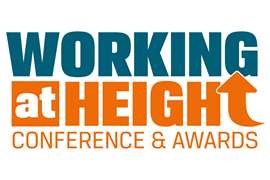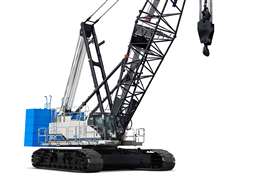Untapped markets are showing interest in mini crawler cranes
15 March 2011

The world is opening up to mini crawler cranes as untapped markets are beginning to realise their value.
The economic downturn has been unkind to the mini crawler crane, as it has with many of its larger cousins, but this hides massive potential across the world.
Product ranges are limited, however, because mini cranes, by their nature, lose their value above a certain size and new models are now less common as manufacturers have filled their ranges.
One of them is the 2.9 tonne Maeda LC383B, launched as a prototype at Bauma 2010, and now being delivered to the market. About 15 units have been sold across northern Europe, says Christer Dijner, managing director of AB Kranlyft, Maeda dealer for Europe, Middle East, North Africa and Russia.
By the time the last unit is delivered it is hoped the market will start to pick up. "They will be delivered by February, after that we are getting some more models coming in and then we hope the market will start moving. People are waiting as long as possible to renew their fleets, and cross-hire as much as possible in the meantime. We do see an increase in demand, especially in the Scandinavian market. But companies are saying they won't invest until the end of March - the end of winter. Some countries there are no investments at all like in Ireland, England, Spain and Greece," Dijner says.
Unic Cranes Europe has completed the CE marking of its URW-245, which sits between the URW-095 and URW-295. Capacity is 2.43 tonnes at 1.5 m radius. Maximum working radius is 5.85 m and boom length is 6.19 m. It too will be looking for orders in a retracted market.
Graeme Riley, CEO at GGR group, Unic Cranes Europe parent company, puts France as the strongest European market but echoes Dijner's view that the once-fruitful German market has seen a drop off in the last 12 months. Eastern Europe is a developing market with sales in the Czech Republic and Romania, where the company has a dealer.
"People are looking for new markets because the domestic markets have slowed down. We have also got a branch in Dubai called GGR Gulf. We exhibited there and sold a couple of cranes from the exhibition. Dubai has slowed down but Abu Dhabi is the place where most of the things are going on."
Kranlyft is looking to new markets, with attempts to set up a distributor in Saudi Arabia to take advantage of huge growth there and in Abu Dhabi. Russia is another target, where Kranlyft has set up a new distributor. The company has been service training at the site since January. "There aren't any mini cranes in Russia, so they have to go for the Japanese or western European models," says Dijner.
Potential
There are about 10,000 mini cranes working in Japan, which has a population of 128 million, according to Dijner. "If you make a per capita calculation on that you should sell some 20,000 mini cranes in Russia. Of course, all markets and circumstances are very different, but even if the figure is half true, they are going to need a lot of mini cranes."
The USA is also showing potential. Kranlyft started selling mini crawlers there a couple of years ago but in no real volume until 2010. Maeda USA will exhibit at ConExpo in March with most of the range but with different options for the US market. This compares to ConExpo 2007 when the distributor had a small stand with a limited range.
Demonstrating its faith in the US market, Italian crane manufacturer Jekko will launch its SPX1040 with extendable tracks at ConExpo. The mini crawler is based on the company's standard model but allows 360° slewing when the tracks are fully extended. The folded crane dimensions are slightly higher at 2,050 x 2,050 mm, but the length remains the same at 5,300 mm. It is 700 kg heavier than the standard one at 6,950 kg with counterweight.
The four stage, 14.5 m boom is the same as the standard version and has a lattice flying jib and stinger with maximum working height of 22.5 m.
The pick-and-carry function is possible at the front and back. The tracks extend independently but must be fully extended all the way for 360° pick-and-carry.
Don Lucas, manager at Encore Trucking, based in western Canada, also sees a future for the mini crawler in North America. The company has 15 Unic 295s, a Maeda 285 and a 355 and a 5 tonne capacity IHI, plus a pair of 8 tonne Starlifters.
"The Unic 295s are especially useful because of the leg position flexibility. We keep all power varieties in stock and, perhaps, it is still the early stages of industrial use but we find the electric models are not used a quarter as much as we had thought. The propane gas models are the most in-demand."
Value
By late February 2011 Encore's sales division had sold five mini crawlers, double the number sold in the whole of 2010. It is hoped a further five will be sold by the end of the third quarter. "Most of the use has been in industrial situations, oil refineries, compressor stations, power plants and pulp mills. But the medium industrial situations; the glass installers, and landscapers, plumbers, and mechanical services, and millwrights have just started to realise the value of these machines."
In Europe, there is similar scope for improved sales, says Italian manufacturer Kegiom. At the time of writing it was about to launch its 200E3 compact spider crane. "In the building industry the use of big cranes isn't always simple. The boom length can create manoeuvrability problems. Therefore, an excellent alternative can be found in mini cranes. And they can be used in many other areas: machinery handling; chemical and petroleum industries; plant engineering; marine equipment handling and agriculture.
As Riley confirms, ground pressure and space is the main issue when choosing a mini crawler, "With mini cranes everything is about foot loadings and the weight you can put on the floor. There are ways around it but sometimes you end up putting down 12 railway sleepers per outrigger to try and get the point loadings down.
"The 094 is the smallest crane in the range and does not quite have the capacity you sometimes need to bring in 500 kg bits of steel work or curtain walling up the side of the building, so that's where the 245 comes in. It is more powerful but still has a light footprint."
Higher capacity
The Maeda LC383M-5B is the smallest of its models with a cabin from the diesel LC range. It is designed to work without outriggers. The larger two cranes in the range: LC785B and LC1385B, have not got outriggers either - "These are what we call the real mini cranes because when working they take up such a small ground space. For instance, when working in a structure between two buildings," says Dijner.
There is more to come in the LC range, says Dijner. "But it's probably going on the bigger side. The LC1385B is the strongest crane in the range, with a boom length, including jib, of 21 m. The next model that I can see is similar to the LC1385B but with a longer boom, and a little bit higher capacity as well."
While range-topping is at the back of everyone's mind at Maeda, says Dijner, the design process has not yet started; rather there is a concentration on updating existing models first.
Riley agrees that unlike with their larger cousins the crawler cranes, mini crawlers, by definition, have a limit in their size and capacity offering. Unic's existing 6 tonne URW-706 is probably as far as the range will go in terms of capacity. "Once you go bigger, you're into a crawler crane or a small mobile." The 706 has 23 m of reach.
The spider crane is still quite young - they have got everything right and they are working well. They will be developing attachments for them but I can't see many ways to radically improve them at the moment," Riley says.
Dijner adds that the electric MC spider crane range is unlikely to change much in the near future, "You are working differently when working indoors because, for example, you don't need the long boom. There's not much more you can develop those cranes. You can make a crane between the 3 and 4 tonne models but indoors it's going to do exactly the same job as those two cranes can do."
Riley agrees that new and diverse attachments, applications and upgrades, often customised, will become increasingly common. An example from Unic is a robotic arm for working close to nuclear reactors. Then there is the battery-powered 295, which has already been used in airports. The same model has also been used in war zones. Riley says one was carried in the back of a Chinook helicopter in Afghanistan to collect debris. A number of other models are also finding work in the region.
Upgrades at Maeda are also ongoing. "For instance, we are going to upgrade the MC285. Today that model has a searcher hook with about 300 kg capacity. We are looking to have a searcher hook with minimum700 kg," says Dijner.
Environmental options are also developing, for example with intelligent throttle activation. "Our cranes have an auto rev to coincide with the load you are lifting, so if the hydraulics are demanding the engine to rev higher they will automatically do that." Again, there are limitations. "The engines are so small we are not doing kinetic energy recovery systems or anything like that at the moment."
GGR also offers cranes for rental, an area that is proving consistently strong, says Riley. "The only thing is that rates are about 40% lower than two or three years ago. When mini cranes came out you had something that one else had and you could command very strong rates. Now there are lots out in the market, so competition has brought rates down."
Customer focus
Don Lucas is anticipating increased demand but says it will be a process of education, demonstration; and trying to increase the industrial and public awareness of them. Concerning mini spider type cranes, Lucas says the design with their flexible leg positioning, load limiting sensors on the legs, has proven to be a great system. He adds, however, that all concerned must listen to customers. "We truly mourn the full LMI and rigid legs on the larger models. It turns an agile spider into a clumsy crab. They certainly have their place and yes we will use larger models, but the weapon of choice will continue to be the Unic 295."
"What we as suppliers and renters have to remember: if our equipment and our machines are good enough they will succeed on their own merit. The deal will happen in your customer's mind. They will know of situations, circumstances, access issues, tight lift problems, that you won't be able to imagine," Lucas adds.






